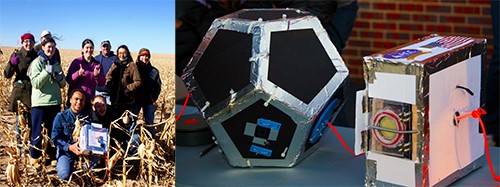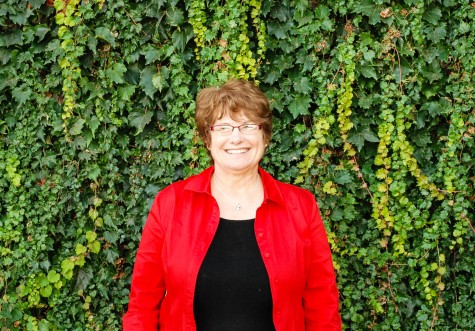ACC students’ experimental balloon goes to edge of space above eastern Colorado

Image via Photo Courtesy of ACC Office of College Communications
Early risers standing in cornfield south of Limon – at 39.19633 degrees latitude and 103.70350 degrees longitude – on Nov. 7 at exactly 9 a.m. might have been surprised when the remnants of a hydrogen balloon and the payload built my ACC students landed at their feet if not on their heads.
The EOSS-216 hydrogen balloon, lying in tatters, was launched at 7:10 that morning from Deer Trail, Colo., carrying the ACC DemoSat team’s payload designed to test mechanical doors that might be used in future flights to gather biological specimens.
The ACC DemoSat team, part of the Colorado Space Grant Consortium (COSGC), created a payload to be carried on the Edge of Space Sciences (EOSS) high altitude hydrogen balloon. The balloon ascended for 83 minutes reaching 95,000 feet before it burst and returned the payload to earth in the Limon cornfield. While the balloon was aloft it was visible to the students as a tiny white speck.
When the balloon burst, it became impossible to see with the naked eye. EOSS equips their balloons with GPS tracking systems and the students were able to continue to track the payload electronically and determine its final resting place.
Rebekka Spidell, a member of the DemoSat team, said the experiment for the payload changed several times during the semester. Spidell said, “… originally we planned to send up filters [to test for bacteria] and then bring them down and run them through…tests that at the very least would allow us to say that we found bacteria at such and such an altitude and viruses as such and such an altitude.”
What the team discovered was searching for bacteria was slightly more complicated and their experiment would take more time and greater resources than they had at their disposal.
So, from there they decided to test mechanical doors to see how they would perform at roughly 95,000 feet where another experiment could look for bacteria using these doors.
Spidell said one of the mechanical doors opened completely but the other test door did not perform as well. Despite any failures, Spidell feels the team learned valuable lesson about what did not work, and they or the next team to try this experiment will benefit from those failures.
ACC DemoSat students worked on the payload during the Fall semester, guided by two moderators, Astronomy faculty member Jennifer Jones and Physics faculty member Henry Weigel. They were available to advise and offer assistance when necessary. Students were also able to use resources provided by the COSGC.
The Colorado Space Grant Consortium (COSGC), funded by NASA, sponsors the DemoSat teams at colleges around Colorado, and it is with COSGC support that ACC students were able to build the payload for the Edge of Space Sciences hydrogen balloon.
ACC belongs to EOSS, a non-profit organization staffed by volunteers who assist students with their payloads and facilitate the launch of the high-altitude balloons. The balloons typically reach 95,000 feet, which is above 99% of the Earth’s atmospheric mass. This altitude is not readily accessible for ground based aircraft and only available to rockets for a short amount of time. Thus, gas balloons are the most efficient vessels to use for exploration at these heights which is often called the edge of space.
This is the second year ACC has participated in the EOSS hydrogen balloon launch. It is not necessary to part of the Astronomy program at ACC to become part of the DemoSat team.
For more information, please email Jones or call her at 303-797-5839.

Geraldine Smith is a reporter for the Arapahoe Pinnacle. She is a second-year, non-traditional student at ACC. (Her grown children have to help with some of the technology and a lot of the math.)
Often the oldest in class, she feels...


